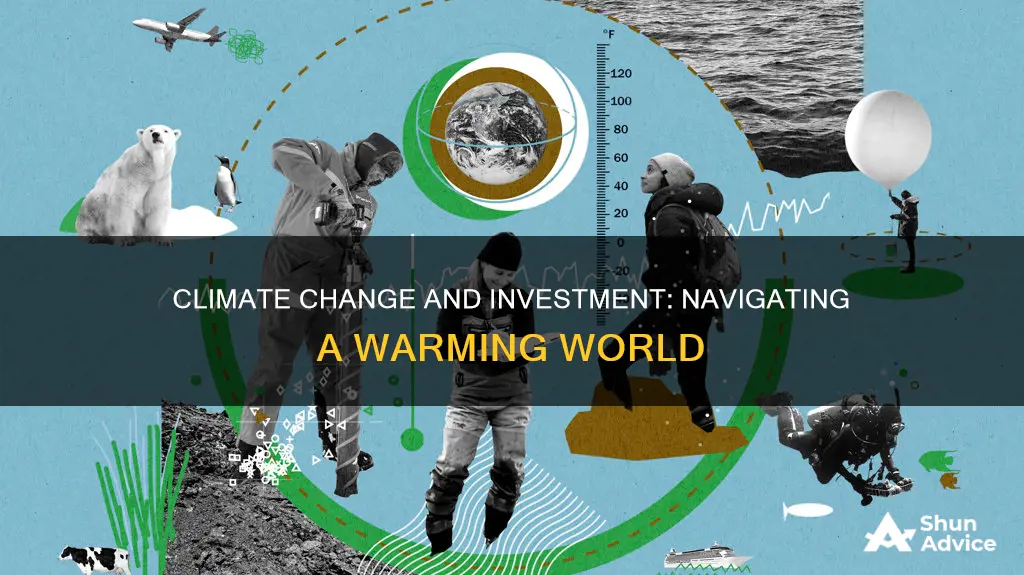
Climate change is causing long-term shifts in temperatures and weather patterns, with human activities being the main driver of this change due to the burning of fossil fuels. The consequences of climate change include intense droughts, water scarcity, severe fires, rising sea levels, flooding, melting polar ice, catastrophic storms, and declining biodiversity. These changes pose risks to investments, and investors are increasingly seeking opportunities to mitigate these risks and aid in the transition to a low-carbon economy. Climate investments fall within the realm of environmental, social, and governance (ESG) investing, which seeks to accomplish positive social benefits alongside profits. While climate investments have traditionally had lower returns, this gap is closing, and investors are increasingly recognizing the potential for financial gains and social impact.
| Characteristics | Values |
|---|---|
| Global temperature increase | 1.1°C-1.2°C above pre-industrial levels |
| Time period | Since the Industrial Revolution |
| Main cause | Greenhouse effect |
| Greenhouse gases | Carbon dioxide, methane, nitrous oxide, water vapour, fluorinated gases |
| Impact | Extreme weather, droughts, water scarcity, wildfires, rising sea levels, flooding, melting polar ice, declining biodiversity, etc. |
| Action required | Reducing greenhouse gas emissions, adapting to climate impacts, financing required adjustments |
What You'll Learn
- Green bonds issued by companies, governments, and banks to fund projects that help slow climate change
- Alternative energy sources, such as solar and wind power
- Green transportation, including electric vehicles
- Green technology, including vertical farming and food waste management
- Green initiatives, such as carbon offsets and sustainable materials

Green bonds issued by companies, governments, and banks to fund projects that help slow climate change
Green bonds are issued by companies, governments, and banks to fund projects that help slow climate change. They are a type of fixed-income investment, offering investors a stated return and a promise to use proceeds to finance sustainable projects. Green bonds are meant to encourage sustainability and support climate-related projects, such as renewable energy, energy efficiency, clean public transportation, pollution prevention, conservation, and sustainable water and waste management. They also support the development of environmentally friendly technologies and climate change mitigation.
The World Bank is a major issuer of green bonds, reporting $40.8 billion in bonds issued in 2022, with funds going towards projects for energy and efficiency (33%), clean transportation (27%), and agriculture and land use (15%). The World Bank's green bond projects are designed to reduce poverty and improve local economies, with a specific focus on addressing climate change issues in developing countries.
Green bonds are often verified by third-party organizations, such as the Climate Bonds Standard Board, which certifies that the bond will fund environmentally beneficial projects. They may also have tax incentives that make them more attractive to investors.
The demand for green bonds is expected to increase in the coming years due to cheaper borrowing costs and European regulations that improve the transparency, comparability, and credibility of the green bond market. In 2023, sales of green bonds climbed to a record $575 billion, with $190 billion issued by governments.
Green bonds are part of a larger trend in socially responsible and environmental, social, and governance (ESG) investing. ESG funds had an estimated $2.7 trillion in assets under management in 2021, and green bonds are an important tool for investors who want to support climate solutions and avoid businesses that contribute to climate change.
Invest Now: Where to Put Your Money
You may want to see also

Alternative energy sources, such as solar and wind power
Solar and wind power are two of the most well-known sources of alternative energy. Both are entirely renewable and clean, posing no threat to the environment, the atmosphere, or human health.
Solar energy is captured using photovoltaic (PV) cells, commonly known as solar panels. The sun's rays are so powerful that just one hour of sunlight is sufficient to power the entire planet for a year. Semiconductors within the PV cells capture the sun's rays by absorbing the sunlight and then work to knock the electrons loose to produce solar energy, which can then be harnessed to create electricity.
Solar energy is completely renewable, and the costs of installation can be made back through energy bill savings. The only potential drawback of solar panels is that they are prone to deterioration over time and are not completely weather-safe in countries with erratic weather conditions.
Wind energy is another widely used alternative energy source. Wind power is sustainable, renewable, and does not release carbon emissions as a byproduct. Wind energy is generated using wind turbines, which cause kinetic energy when they spin, and this kinetic energy is then converted into electricity using a generator.
Wind turbines are relatively inexpensive to build and maintain, and a typical wind farm repays its carbon footprint in around six months or less, providing decades of zero-emission energy. The main disadvantages of wind turbines are that they can be noisy and are considered by some to be eyesores. They can also be dangerous to birds and other flying wildlife.
Both solar and wind power have experienced a significant increase in usage in recent years, with solar power experiencing a 4,300% increase in the world's total installed energy capacity from 2007 to 2017, and wind capacity increasing more than 22-fold from 2001 to 2017.
The transition to renewable energy sources such as solar and wind power is crucial in the fight against climate change. Fossil fuels, such as coal, oil, and gas, are the largest contributors to global climate change, accounting for over 75% of global greenhouse gas emissions. By investing in alternative energy sources, we can reduce our carbon footprint, protect the environment, and create a more sustainable future.
Pay-to-Play" Investment: Unlocking Opportunities or Unfair Advantage
You may want to see also

Green transportation, including electric vehicles
Electric vehicles (EVs) are widely regarded as the future of green transportation. They are seen as an optimal solution to reduce our dependence on fossil fuels in the transportation sector. By transitioning from traditional internal combustion engine vehicles to EVs, we can significantly reduce greenhouse gas emissions and mitigate climate change.
EVs have gained popularity due to their zero-emission profiles and environmental benefits. They produce no tailpipe emissions, improving air quality and reducing our carbon footprint. Additionally, EVs are more energy-efficient, as they convert a higher percentage of stored energy into propulsion, resulting in reduced energy consumption and fossil fuel dependency. The development and advancements in battery technology have played a crucial role in enhancing the performance and range of EVs, making them a more practical and attractive choice for consumers.
The shift towards EVs is gaining global momentum. According to the 2022 Global Electric Vehicle Outlook from the International Energy Agency, electric car sales reached a new record of 6.6 million in 2021, doubling the previous year's rate. This growth is driven by several factors, including increasing concerns over climate change, air pollution, and the finite nature of fossil fuels.
To support the adoption of EVs, governments worldwide are implementing incentives and policies, such as tax credits, subsidies, and stricter emissions regulations. These initiatives aim to make EVs more affordable and accessible to consumers, encouraging a shift towards sustainable transportation. For example, in August 2021, President Biden signed an executive order setting targets for 50% of all new passenger cars and light trucks sold in 2030 to be zero-emissions vehicles.
The private sector is also playing a significant role in the transition to EVs. Leading automakers are investing heavily in EV development, offering consumers a wide range of options. Companies like Tesla, Rivian Automotive, NIO, and Lucid Group are dedicated solely to electric vehicle production. Established automotive manufacturers like General Motors, BMW, Toyota, and Ford are also adapting to electric mobility, investing billions in EV development and production.
In addition to passenger cars, the electrification of heavier vehicles such as trucks and buses is gaining traction. Corporate fleets are slowly but steadily transitioning to electric options, with companies like DHL and Hertz leading the way. This shift has the potential to significantly reduce emissions, as the transport sector accounts for 28% of all emissions.
The integration of EVs with renewable energy sources is another important aspect of green transportation. Electricity used to power EVs can be generated from solar, wind, and hydroelectric power, further enhancing their green credentials. This transition to cleaner energy sources is crucial in the fight against climate change and air pollution.
While EVs offer numerous benefits, there are some challenges to their widespread adoption. One of the main concerns is the limited charging infrastructure, which can cause range anxiety among potential EV owners. However, advancements in battery technology are addressing these concerns, and the expansion of charging networks is ongoing.
In conclusion, green transportation, including electric vehicles, is a crucial component of our efforts to create a more sustainable future. By embracing EVs, we can significantly reduce our environmental impact, improve air quality, and move towards a cleaner and greener transportation sector. With increasing consumer demand, technological advancements, and supportive policies, we are driving towards a future where electric vehicles are not just a trend but a fundamental shift in how we think about mobility.
Strategic Retirement Planning: Maximizing Your $500K Investment
You may want to see also

Green technology, including vertical farming and food waste management
Green Technology: Vertical Farming and Food Waste Management
Vertical Farming
Vertical farming is a method of growing crops in vertically stacked layers, often integrated into buildings, shipping containers, or greenhouses. This innovative approach to agriculture offers a solution to the challenges of increasing food demand and limited natural resources. By utilising vertical space, farmers can produce significantly more food on the same amount of land or even less. This is especially beneficial in urban areas, where land is scarce and the demand for food is high.
One of the key advantages of vertical farming is the ability to control temperature, light, water, and humidity, creating optimal conditions for plant growth. This controlled environment agriculture (CEA) allows farmers to grow a wider variety of crops year-round, regardless of the external climate. Additionally, vertical farming reduces the impact of extreme weather events, ensuring a more stable food supply.
Vertical farms also contribute to sustainability by reducing water usage, eliminating the need for chemical pesticides, and minimising food waste. With vertical farming techniques, water usage can be reduced by up to 98%, and land usage by 99%. The proximity of vertical farms to urban populations also reduces the carbon footprint associated with food transportation, resulting in fresher produce and lower food waste.
While vertical farming offers numerous benefits, it also faces some challenges. One of the main challenges is the high start-up cost compared to traditional farms, including significant energy demands for lighting and temperature control. However, advancements in technology, such as the use of natural sunlight instead of LED lights, are helping to address these issues and make vertical farming more accessible and sustainable.
Food Waste Management
Food waste management is a critical aspect of addressing global food security and sustainability. According to the Boston Consulting Group (BCG), food waste is expected to rise by a third by 2030, with 2.1 billion tons of food wasted annually. Developed countries often have higher rates of food waste, while hunger and food insecurity persist in many poor countries.
Food waste occurs at every stage of the global food value chain, from agricultural production to final consumption. To address this issue, innovative solutions are being explored, such as collaborating with local farmers, partnering with sustainable suppliers, and implementing waste reduction strategies throughout the supply chain.
The hospitality and foodservice industry, including restaurants, cafes, and catering services, plays a significant role in food waste management. By adopting sustainable practices and raising awareness among employees and consumers, this industry can contribute to reducing food waste and promoting a more circular economy.
In conclusion, green technology, including vertical farming and food waste management, offers promising solutions to address the challenges of climate change and food insecurity. By adopting innovative agricultural practices and reducing waste, we can work towards a more sustainable and resilient future for our planet.
The S&P 500: A Safe Harbor for Retirement Savings?
You may want to see also

Green initiatives, such as carbon offsets and sustainable materials
Carbon Offsets
Carbon offsets are a way for individuals and organisations to compensate for their carbon emissions by funding projects that reduce or absorb carbon dioxide. The goal is to create a net-zero carbon footprint by balancing out emissions with equivalent reductions or removals elsewhere. Carbon offsets can take various forms, including:
- Renewable energy initiatives: Investing in wind, solar, or hydropower projects to increase the amount of renewable energy on the grid and reduce reliance on fossil fuels.
- Reforestation and conservation: Planting new trees or protecting existing ones to capture carbon and preserve ecosystems.
- Methane capture: Reducing methane emissions from landfills and agriculture, one of the most potent greenhouse gases.
- Waste-to-energy projects: Capturing methane from waste and converting it into electricity.
Sustainable Materials
Sustainable materials are those that have a lower environmental impact throughout their lifecycle, from production to disposal. They can include:
- Recycled content: Using recycled materials reduces the need for virgin resources and can reduce energy consumption and pollution associated with manufacturing.
- Bio-based materials: These are made from renewable biological resources, such as bamboo or plant-based plastics, which can be more easily biodegradable or recyclable.
- Low-carbon alternatives: Some materials have lower carbon footprints than others. For example, choosing timber over concrete can reduce the carbon intensity of construction.
Benefits of Green Initiatives
Green initiatives provide both environmental and social benefits. They help to reduce carbon emissions and mitigate climate change, preserve ecosystems and biodiversity, and improve air and water quality. Additionally, they can provide economic opportunities and empower local communities, particularly in developing countries. Green initiatives can also enhance a company's reputation and demonstrate its commitment to environmental responsibility and sustainability.
Challenges and Considerations
However, there are also challenges and considerations when it comes to green initiatives. Carbon offsets, for example, should not be seen as a replacement for direct emission reductions. They are most effective when used in combination with efforts to reduce emissions at the source. Additionally, there are concerns about "greenwashing", where companies use carbon offsets to mask their unethical behaviour or continue harmful practices. It is important for investors and regulators to ensure transparency and credibility in green initiatives to avoid this issue.
Inheriting Wealth: How to Invest
You may want to see also
Frequently asked questions
Climate investing falls within the realm of environmental, social, and governance (ESG) investing. Climate investments support technologies or companies that are likely to become important as the world transitions away from fossil fuels and carbon-intensive industries.
Climate change poses two kinds of risks that investors might consider: "physical risk" from the direct effects of climate change, and "transition risks" related to the changes people and governments are making to reduce the effects of climate change.
Climate-focused investments include renewable energy, green bonds, and companies with strong investments in carbon offsets, sustainable materials, electric vehicles, and other low-carbon alternatives.
Investment decisions can affect stock prices and bond yields, and there is a risk of "greenwashing", where funds market themselves as more environmentally friendly than they are. Climate-focused investors also risk doing worse financially by rejecting profitable investments over climate concerns.







